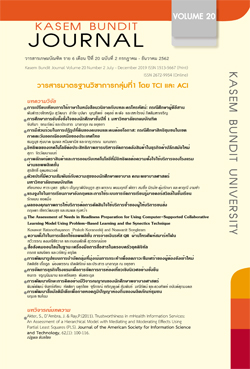Akter, S., D’Ambra, J. & Ray,P.(2011). Trustworthiness in mHealth Information Services: An Assessment of a Hierarchical Model with Mediating and Moderating Effects Using Partial Least Squares (PLS). Journal of the American Society for Information Science and Technology, 62,(1): 100-116.
คำสำคัญ:
ตัวแบบเส้นทางกำลังสองน้อยที่สุดบางส่วน, ตัวแปรกำกับ, ตัวแปรแทรกกลางบทคัดย่อ
บทความวิจัยจากผลการวิจัยซึ่งวิเคราะห์ข้อมูลด้วยวิธีตัวแบบเส้นทางกำลังสองน้อยที่สุดบางส่วนเพื่อประเมินตัวแบบในการอำนวยบริการเกี่ยวกับการแพทย์ทางไกล โดยมีความน่าไว้วางใจของผู้ให้บริการเป็นตัวแปรแฝงเชิงชั้น และเป็นตัวแปรอิสระ ซึ่งมีทั้งอิทธิพลโดยตรง และโดยทางอ้อม ผ่านตัวแปรความไว้วางใจของผู้บริโภคต่อตัวแปรการใช้บริการต่อเนื่องซึ่งเป็นตัวแปรตาม ผลการวิเคราะห์แสดงให้เห็นด้วยว่า ตัวแปรความน่าไว้วางใจของผู้ให้บริการไม่เป็นตัวแปรกำกับอิทธิพล ระหว่างตัวแปรความไว้วางใจของผู้บริโภคกับความต่อเนื่องในการใช้บริการ
References
Jeon, Jihye. (2015). The Strengths and limitations of Statistical Modeling of Complex Social Phenomenon: Focusing on SEM, Path Analysis, or Multiple Regression Models, International Journal of Social, Behavioral, Educational, Economic, Business and Industrial Engineering. Vol. 9(5): 1634-1642.
Khanthachai, N. (2562). Article Review: Bagozzi, Richard P. (2010). Structural Equation Models Are Modeling Tools with Many Ambiguities: Comments Acknowledging the Need for Caution and Humility in Their Use. Journal of Consumer Psychology 20(210): 208-214. Kasam Bundit Journal, Vol.20 (special edition) April-May, 2562: 150-153.
MacCallum, Robert C. & Austin, James T. (2000). Applications of Structural Equation Modeling in Psychological Research. Annu. Rev. Psychol. 51: 201-226.
Ronkko, Mikko, McIntosh, Cameron N., Antonakis, John & Edwards, Jeffrey R.(2016) Partial Least Squares Path Modeling : Time for Some Serious Second Thoughts. Journal of Operations Management DOI:10.1016/j.jom.2016.05.002
Rose S. A., Markman, B. & Swilowsky, S. (2017). Limitations in the systematic analysis of structural equation model fit indices. Journal of Modern Applied Statistical Method, 16(1): 69-85.
Tomarken, Andrew J. & Waller, Niels G. (2005). Structural Equestrian Modeling: Strengthes, limitations, and Misconceptions. Annu. Rev. Clin. Psychol. 1: 31-36
Xiaosong Peng, David & Lai, Fujun. (2012). Using Partial Least Squares in Operatrions Management Research: A Practical Guideline and Summary of Past Research. Journal of Operations Management, 30: 467-480.
Downloads
เผยแพร่แล้ว
How to Cite
ฉบับ
บท
License
ทัศนคติ ความคิดเห็นใด ๆ ที่ปรากฏในวารสารเกษมบัณฑิตฉบับนี้เป็นของผู้เขียน โดยเฉพาะ มหาวิทยาลัยเกษมบัณฑิตและบรรณาธิการ ไม่จำเป็นต้องมีความเห็นพ้องด้วย






